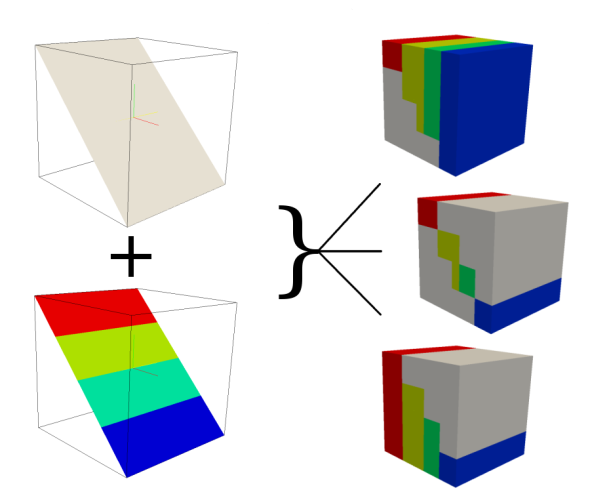r.to.rast3elev
Creates a 3D volume map based on 2D elevation and value raster maps.
r.to.rast3elev [-ulm] input=name [,name,...] elevation=name [,name,...] output=name [upper=float] [lower=float] [tilesize=integer] [--overwrite] [--verbose] [--quiet] [--qq] [--ui]
Example:
r.to.rast3elev input=name elevation=name output=name
grass.script.run_command("r.to.rast3elev", input, elevation, output, upper=None, lower=None, tilesize=32, flags=None, overwrite=None, verbose=None, quiet=None, superquiet=None)
Example:
gs.run_command("r.to.rast3elev", input="name", elevation="name", output="name")
grass.tools.Tools.r_to_rast3elev(input, elevation, output, upper=None, lower=None, tilesize=32, flags=None, overwrite=None, verbose=None, quiet=None, superquiet=None)
Example:
tools = Tools()
tools.r_to_rast3elev(input="name", elevation="name", output="name")
This grass.tools API is experimental in version 8.5 and expected to be stable in version 8.6.
Parameters
input=name [,name,...] [required]
Name of input raster map(s)
elevation=name [,name,...] [required]
Name of input elevation raster map(s)
output=name [required]
Name for output 3D raster map
upper=float
The value to fill the upper cells, default is null
lower=float
The value to fill the lower cells, default is null
tilesize=integer
The maximum tile size in kilo bytes. Default is 32KB.
Default: 32
-u
Use the input map values to fill the upper cells
-l
Use the input map values to fill the lower cells
-m
Use 3D raster mask (if exists) with input map
--overwrite
Allow output files to overwrite existing files
--help
Print usage summary
--verbose
Verbose module output
--quiet
Quiet module output
--qq
Very quiet module output
--ui
Force launching GUI dialog
input : str | list[str], required
Name of input raster map(s)
Used as: input, raster, name
elevation : str | list[str], required
Name of input elevation raster map(s)
Used as: input, raster, name
output : str, required
Name for output 3D raster map
Used as: output, raster_3d, name
upper : float, optional
The value to fill the upper cells, default is null
lower : float, optional
The value to fill the lower cells, default is null
tilesize : int, optional
The maximum tile size in kilo bytes. Default is 32KB.
Default: 32
flags : str, optional
Allowed values: u, l, m
u
Use the input map values to fill the upper cells
l
Use the input map values to fill the lower cells
m
Use 3D raster mask (if exists) with input map
overwrite : bool, optional
Allow output files to overwrite existing files
Default: None
verbose : bool, optional
Verbose module output
Default: None
quiet : bool, optional
Quiet module output
Default: None
superquiet : bool, optional
Very quiet module output
Default: None
input : str | list[str], required
Name of input raster map(s)
Used as: input, raster, name
elevation : str | list[str], required
Name of input elevation raster map(s)
Used as: input, raster, name
output : str, required
Name for output 3D raster map
Used as: output, raster_3d, name
upper : float, optional
The value to fill the upper cells, default is null
lower : float, optional
The value to fill the lower cells, default is null
tilesize : int, optional
The maximum tile size in kilo bytes. Default is 32KB.
Default: 32
flags : str, optional
Allowed values: u, l, m
u
Use the input map values to fill the upper cells
l
Use the input map values to fill the lower cells
m
Use 3D raster mask (if exists) with input map
overwrite : bool, optional
Allow output files to overwrite existing files
Default: None
verbose : bool, optional
Verbose module output
Default: None
quiet : bool, optional
Quiet module output
Default: None
superquiet : bool, optional
Very quiet module output
Default: None
Returns:
result : grass.tools.support.ToolResult | None
If the tool produces text as standard output, a ToolResult object will be returned. Otherwise, None will be returned.
Raises:
grass.tools.ToolError: When the tool ended with an error.
DESCRIPTION
r.to.rast3elev creates a 3D volume map based on 2D elevation and value raster maps. If the 2d and 3d region settings are different, the 2d resolution will be adjust to the 3d resolution.
NOTES
The height of the 2D elevation maps will be used to verify the position within the 3D region. If the cell value of the elevation raster maps is located within the 3D region, the cell value of the appropriate 2D input raster maps will be written to the associated 3D cell. There are flags and options to fill the upper and lower 3D cells with a specific value, or the input raster maps values.
EXAMPLES
Simple Spearfish sample data set example
g.region raster=elevation.10m -p
g.region res=200 res3=200 t=2000 b=0 tbres=20 -p
# Write the values of raster map soils based on the elevation of elevation.10m
# to the 3D map volev
r.to.rast3elev in=soils elev=elevation.10m out=volev
# Write the values of map soils based on the elevation of elevation.10m
# to the 3D map volev_l and fill the lower cells with the soils map values
r.to.rast3elev in=soils elev=elevation.10m out=volev_l -l
# Write the values of map soils based on the elevation of elevation.10m
# to the 3D map volev_u and fill the upper cells with the soils map values
r.to.rast3elev in=soils elev=elevation.10m out=volev_u -u
# Example with multiple elevation maps.
## first we need three support maps
r.mapcalc expression="one = 1"
r.mapcalc expression="two = 2"
r.mapcalc expression="three = 3"
## Now we generate the new evelation maps
r.mapcalc expression="elev_mid = elevation.10m - 500"
r.mapcalc expression="elev_bottom = elevation.10m - 1000"
## Now fill the lower cells below the elevation maps with the values one, two and three
r.to.rast3elev -l input=one,two,three elevation=elevation.10m,elev_mid,elev_bottom output=threelayer
## Export the map for visualization with paraview (https://www.paraview.org)
## By default the null value is -9999.99, we adjust it to 0.0 for
## better visualization
r3.out.vtk null=0.0 input=threelayer output=/tmp/threelayer.vtk
# Start paraview
paraview --data=/tmp/threelayer.vtk
# Note: First you need to choose the surface representation style and
# then color by "threelayer" in paraview.
SEE ALSO
r.to.rast3, r3.cross.rast, g.region
AUTHOR
Soeren Gebbert
SOURCE CODE
Available at: r.to.rast3elev source code
(history)
Latest change: Tuesday Feb 18 17:20:26 2025 in commit 688e625
